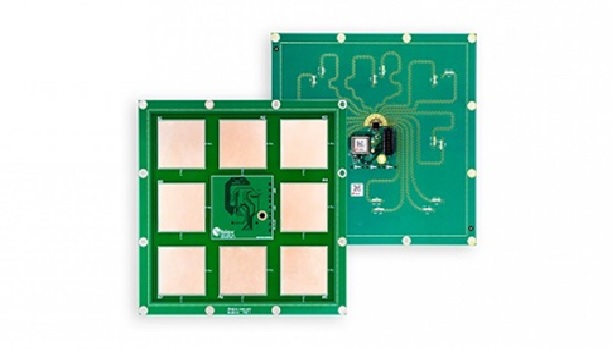Bluetooth Indoor Positioning Antenna Board for Commercial End-Products
The low power, high presision antenna board quickly brings reliable indoor positioning solutions to market. The ANT-B10 antenna board by u-blox for Bluetooth direction finding and indoor positioning applications enables low power, high precision indoor positioning and speeds up evaluation, testing, and commercialisation of Bluetooth direction finding and indoor positioning solutions including integration into commercial end-products.
Bluetooth indoor positioning uses the angle of arrival (AoA) of a Bluetooth direction finding signal emitted by a mobile tag at several fixed anchor points to calculate the tag’s location in real-time with sub-meter accuracy. The low-cost technology allows high accuracy and can be installed and maintained. [1]

Figure 1. The Bluetooth Indoor Positioning Antenna Board for Commercial End-Products
Figure 1 shows ANT-B10 is a self-contained Bluetooth low energy antenna board for direction finding and indoor positioning. The board, which features an antenna array comprising eight individual patch antennas, is built around a u blox NINA-B411 Bluetooth 5.1 module. After processing incoming RF signals emitted by mobile tracker tags in the module’s radio and angle calculation processor, the solution outputs the calculated angle of arrival without requiring any additional processes. [2]
Ready to go for end-product integration
ANT-B10 and XPLR-AOA-3 complements the existing u-blox indoor positioning offering, which includes the popular XPLR-AOA-1 and XPLR-AOA-2 kits. Using u-connectLocate, which runs on ANT-B10's Bluetooth module, solution developers can easily execute the angle calculation algorithms using AT commands. When combined, the solution suite is ready to go for end-product integration.
Common use cases for Bluetooth indoor positioning and direction include tracking assets in industrial settings such as in warehouses as well as people and things in hospitals, retail environments, or museums. Additionally, access control systems deployed in connected buildings can use angle detection to determine which side of a door users are located on. [3]
To determine the angle of arrival of incoming signals for direction finding, the ANT-B10 board concurrently processes them on all eight patch antennas. Implementing multiple RF paths connected to multiple RF switches unnecessarily increases power demand and introduces errors, so the ANT-B10 board uses a single RF switch component from CoreHW that cycles through the eight antennas in microseconds. [4]
References:
- https://www.electronicsforu.com/special/truly-innovative-tech/bluetooth-indoor-positioning-antenna-board-commercial-end-products
- https://www.u-blox.com/en/u-blox-launches-Bluetooth-indoor-positioning-antenna-board-for-commercial-end-products
- https://markets.businessinsider.com/news/stocks/u-blox-ag-u-blox-launches-bluetooth-indoor-positioning-antenna-board-for-commercial-end-products-1031280141
- https://smartcitieselectronics.com/u-blox-antenna-board-enables-bluetooth-positioning-indoors/
Cite this article:
Thanusri swetha J (2022), Bluetooth Indoor Positioning Antenna Board for Commercial End-Products, Anatechmaz, pp. 207

